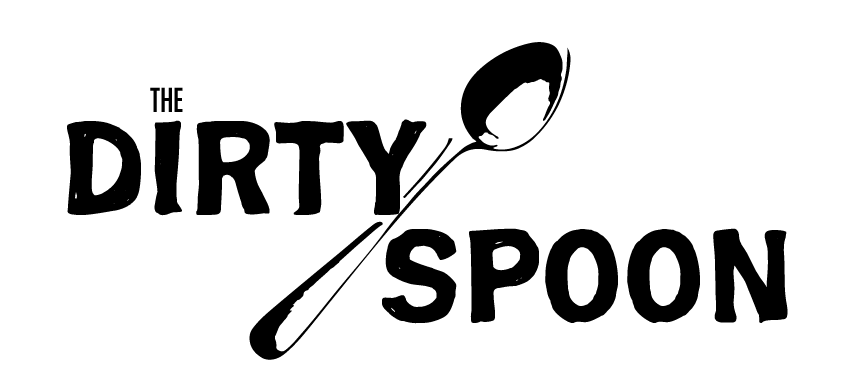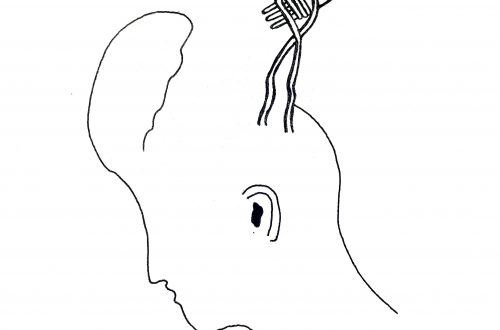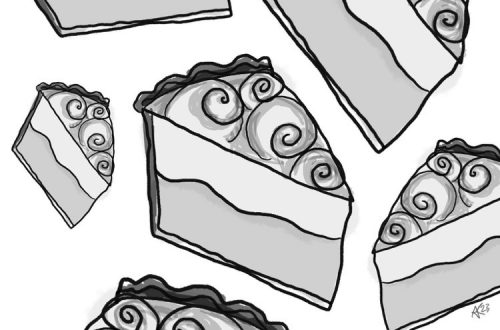by Mandy Shunnarah
Mandy’s interview appears in episode 33 of The Dirty Spoon Radio Hour.
It’s estimated that one in every two thousand people have some form of synesthesia––an extra-sensory condition that allows people to smell color and taste a feeling, for example. Food photographer and recipe developer Jessica Furniss is one of them, and the ability manifests itself in surprising ways in her concoctions.
Furniss loves 1940s and ‘50s music, so she created a recipe series where she turns big band songs into drinks. She does this with coffee, tea, cocktails, mocktails, and lots of edible glitter.
What began as a creative way to combine her love of jazz music and fancy drinks turned Furniss into a TikTok sensation amassing more than 116,000 followers. Creating these drinks from old songs has allowed her to leverage her following for causes she believes in, like supporting food businesses owned by women of color, advocating for the LGBTQ+ community, educating people about intuitive eating and food freedom, and advocating for social media influencers’ labor rights. Though it’s opened her up to many opportunities, being a food influencer isn’t as glamorous as TikTok might have viewers believe.
I talked to Jessica about her work in food and activism. Our conversion has been lightly edited for length and clarity.
Mandy Shunnarah: You use your synesthesia to hear songs and make recipes based on them, so walk us through what’s happening in your head from the moment you hear a song and decide to make a drink recipe from it.
Jessica Furniss: I’ll listen to a song, sometimes just once, and the drink instantly comes to mind and sometimes I listen to a song several times over a week. The drink kind of creates itself. The song tells me what its drink is.
For instance, “Fly Me to the Moon” by Frank Sinatra. There’s a vintage cocktail called a Paper Plane [called Last Word in the Prohibition era] and I was like, ‘Of course! That’s the drink that goes with this.’ I made a couple of adaptations, but for the most part it was a Paper Plane. Then there are more complicated songs that take a little more digging and interpretation to figure out. What vibe is this song giving me? Is it sultry? Are you imagining being in a smoky jazz club at night surrounded by elegant clothes? A lot of Ella Fitzgerald songs that fit that vibe. Or is it Doris Day singing “On the Sunny Side of the Street”? That’s a bright and cheery yellow drink with sunflower and dandelion syrup with sparkling water to top it off. The songs tell me what the drink is.
MS: Does each song tell you whether it wants to be a cocktail, mocktail, tea, or coffee drink?
JF: A lot of times I have a coffee or tea idea in my head and a cocktail/mocktail idea in my head. So I have to decide which direction I’m going.
MS: Walk us through your favorite recipe.
JF: My favorite cocktail I’ve ever made is based on a song by Glenn Miller called “Moonlight Cocktail.” I love it because the song so strongly informs the drink. The lyrics are “Couple of jiggers of moonlight and add a star / Pour in the blue of a June night and one guitar / Mix in a couple of dreamers and there you are / Lovers hail the Moonlight Cocktail / Now add a couple of flowers, a drop of dew / Stir for a couple of hours ‘til dreams come true.”
There are a lot of directions that are already in the song. So I thought, what would moonlight look like? Probably a deep blue. Some stars: edible glitter. Then edible flowers at the end. I felt a strong connection to the song and I think other people did too when they saw the visual representation of the song in the drink.
MS: My favorite drink of yours is the one for the song “Uranium Fever” and it glows under a blacklight. How on earth did you make it glow?
JF: About ten days of utter frustration and anger, then finally pulling in my partner who informed me that tonic water glows under blacklight. There’s a cult following of certain wartime songs from the 1940s thanks to a video game called Fallout. That particular song is really popular in the game, so I had a connection with gamers––which was cool because I play that game too.
MS: You also use your drinks to advocate for social justice, like your pride flag series.
JF: Unfortunately there’s a lot of anti-trans legislation right now, so we can’t talk about the LGBTQ+ community enough. I decided to turn pride flags into drinks and what I found was that people were so excited to see their particular identity represented. For example, I did the asexual/ace flag. Asexuality has been something that’s hush-hush and people try to make you believe it’s rare, but a lot of people are asexual. So when I shared that a lot of people were like, ‘Wow this is awesome. During pride month I get to see something that’s specifically made for me.’ It was the same when I shared the trans flag.
I learned about a ton of sexual orientations and gender identities that I didn’t even know about. Now on TikTok there are these drink videos, some with close to a million views, that specifically talk about the LGBTQ+ community. It was cool to realize that something I’m doing is making people feel seen and valued. I had some teenagers and young adults popping into my DMs saying, ‘This is awesome because I can make this drink at home and my parents don’t know that it means something. This is a way that I can celebrate without having to sacrifice safety.’ There were two different trans teenagers who said that to me. It’s a really good feeling to know I’ve given them a tool to celebrate who they are.
MS: You also do a lot of anti-diet activism and are a proponent of intuitive eating. Tell us what that means.
JF: For a long time I bought into a lot of pseudoscience about nutrition and food. I believed things like sugar is horrible, gluten is bad for you, you have to eat “clean”––there’s no such thing; the only eating clean is making sure you wash your vegetables. I was caught up in that to the point where I started developing orthorexic eating habits. It ran my life. I couldn’t go out to eat with a friend on a whim, I had to look up the menu and decide what would be okay for me to eat because I had this fear around food making me sick.
Luckily, there have been a lot of medical professionals, doctors and dietitians, who have been sharing that much of the information we have about nutrition is false. There’s a book I’ve been reading called Intuitive Eating [by registered dietitian nutritionists Evelyn Tribole and Elyse Resch] and it specifically addresses how actual overall health is improved by people just listening to their body and their cravings.
People think, ‘Something is wrong with me, why am I binge eating, I’m a failure, I can’t follow a diet.’ It’s because our bodies were never made to diet. Our bodies were made to inform us what we should put in them. I still struggle with fear thoughts around food but intuitive eating has helped me find comfort and satisfaction in food like I did when I was a kid.
MS: What has your experience been like being a viral drink influencer?
JF: It’s very different than I thought it was going to be. I thought it’d bring more personal validation because I’ve been working toward having a larger following for so many years. It’s like, once I get there I’m going to be so happy. You do feel that happiness, but everything in your life is still the same.
I’ve had partnerships where I get paid to post, so that’s different. I also have three or four other close influencer friends and we message each other for encouragement and support. And if you google my name these videos show up, but otherwise my life is exactly the same. That’s good and bad. When you build up all this hope toward something and then you realize my life is the same, there’s that initial disappointment, but overall it’s like, ‘Well duh, of course it’s the same!’ Something like this doesn’t change your entire life.
What it does do is open up more opportunities. I feel very grateful for that but I also know that my whiteness is part of the reason why this was easier for me. So it’s important for me to specifically work with Black-owned brands, Indigenous-owned brands, and brands that are owned by women of color. I now have a platform to help these businesses that are just starting out and I can say here’s info about this brand, go engage with them. I want to acknowledge my privilege and do the best I can with it.
MS: Tell us about some of those brands.
JF: Nuba is a mother and daughter-owned hibiscus tea company that I absolutely love. They created a ready-to-drink hibiscus tea made in the traditional way in Egypt where they’re from. They drink hibiscus tea like how we drink sweet tea in the South.
Another brand I worked with that was amazing is Native Ground Coffee. It’s a Native American-owned coffee company out of Arizona. Their coffee is so delicious––we’ve done espresso, cold brew, iced coffee, and drip coffee with it and it makes all of those well. For my coffee connoisseurs, you know that a lot of times you have to buy different coffee for each of those things.
MS: Since you’re really plugged into the food and drink community as an influencer, what do you want people to understand about that role?
JF: I start creating pitches for fall in early summer, so if September gets here and I share something with pumpkin in it, let me share it because I’ve been sitting on it since the end of May or June. Our timeline is very different. There’s a lot of hate, like ‘How dare you share Christmas stuff before Thanksgiving!’ But I created this Christmas pitch in September, so if I want to share it in November, move along.
There’s also a pretty ignorant meme going around that says something like, ‘Okay, Sarah, just give me the recipe. I don’t want to read your entire life story.’ First of all, someone is giving you a free recipe that they’ve taken the time to photograph, write, and share. When our grandmothers were our age, they had to pay for cookbooks or ask a friend or family member to write recipes down. We can just go on Pinterest and all these incredibly talented people are sharing with us for free.
Second, you have to write in a certain way and a certain length to show up in google searches, so there’s a reason behind why we do that. And third, almost all current blogs have an option for you to click a button that says ‘go to recipe.’ So you don’t have to read all of it, but the whole reason it showed up for you and the reason you get to see it is because that person put so much effort into making sure that they had the SEO to make it show up.
Another thing I’ll say is that in America we’re not doing a good job of sharing food that is not created by white people for white people, and when we do we’re always sharing it through the white lens. So we might just throw on the word fusion and take a classic recipe from another culture to make it more appealing to the white palate. That’s very true in the drink world too.
There’s a lot of white awakening and passing the mic, but what needs to happen is we need to make sure everybody has a mic already and go directly to the source. And we need to make sure we’re paying BIPOC what the white workers in the food industry are being paid.
MS: About equitable pay, some folks want people to work for free and for exposure. I think people look at influencers and think it’s so glamorous and it’s this fabulous lifestyle, yet there’s this side that people don’t see.
JF: I have a lot of respect for small product-based businesses and I know when they’re first starting out they may not have a lot of resources for marketing. However, I’m also a small business, so I have to get paid as well. There has to be a balance between ‘I’m a small business and can’t pay you’ and ‘So am I and I have to get paid.’ I created a small business package where my rates are lower, but when it comes to larger brands, I’m frequently emailed, ‘Hey we went to send you this $15 product and what we expect in return is five full length videos, 10 Instagram Stories and a link on your profile directly to our sales page for a month.’ My question is, would you ask a marketing firm to do that? I’m marketing your product and I can’t do it for free.
There’s a huge issue with large companies seeing influencers as a free way to market. They think influencers just want free stuff and that’s not true. We need to build up this culture of everybody deserves to be paid for the work they do. It’s time for us to stop this patriarchal view that women influencers are just stay-at-home moms who want to have fun and will be grateful for a free $10 product they can post on their blog. We’re past that. We’re professionals and we need to be paid like anybody else.
MS: There’s also a huge difference in doing something in-kind or at a lower rate for a small business that you want to see more of in the world, like Nuba and Native Ground, and this huge big box corporation that has a marketing and advertising budget that they’re choosing not to spend appropriately on your work. Those are very different things.
JF: Yes. Small businesses shouldn’t feel intimidated to reach out, but there’s a way to do it. You can say, ‘Hey I’m a small business, I’ve got this great product and I’d love your support. Are you interested in supporting me by doing anything at all you want to do with this product?’ You’re going to get a totally different response than people who reach out like, ‘We want influencers to join our ambassador program. We’ll give you this thing and all you have to do is post 10 times on Instagram.’
MS: It’s understandable that you’d be protective of your content because you put a lot of work into it. What’s the timeline like from the moment you conceptualize a drink to making it, photographing and filming it, writing the ingredients, posting it on the internet, marketing and resharing it on social media, engaging with the comments…
JF: It’s about a month from the time of conception. I sit down at the beginning of every month and brainstorm based on the season and what’s coming. Like for October I knew I wanted to do the song “Monster Mash.” Then I consider what ingredients I need: What do I have and what do I need to get? I consider when is the best time to share and the best time of day to film because I film with natural light. The actual video that takes five minutes to record is the fun, creative part but the planning and editing are definitely the most time consuming. Several hours usually go into one drink.
MS: What are you excited about in 2022?
JF: My followers have asked me to create a Turning Old Songs Into Drinks cookbook, and I’ve been working on a food photography course and a TikTok course to share what I know with others.
You can see Jessica’s drinks in action on TikTok @jessica_furniss and learn more on her website jessicafurniss.com.
Original artwork by Claire Winkler

About the Author
Mandy Shunnarah is an Alabama-born, Palestinian-American writer who now calls Columbus, Ohio, home. Their essays, poetry, and short stories have been published in The New York Times, Electric Literature, The Rumpus, Entropy Magazine, and others. Their first book, Midwest Shreds: Skaters and Skateparks in Middle America, will be out from Belt Publishing in fall 2022. Read more at mandyshunnarah.com.






